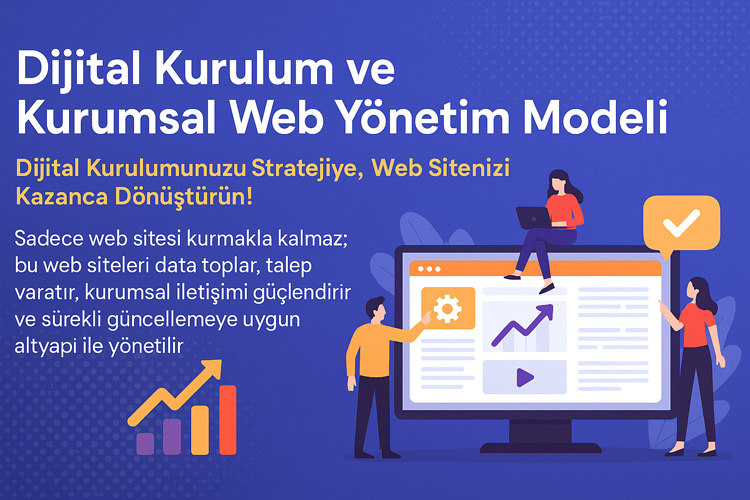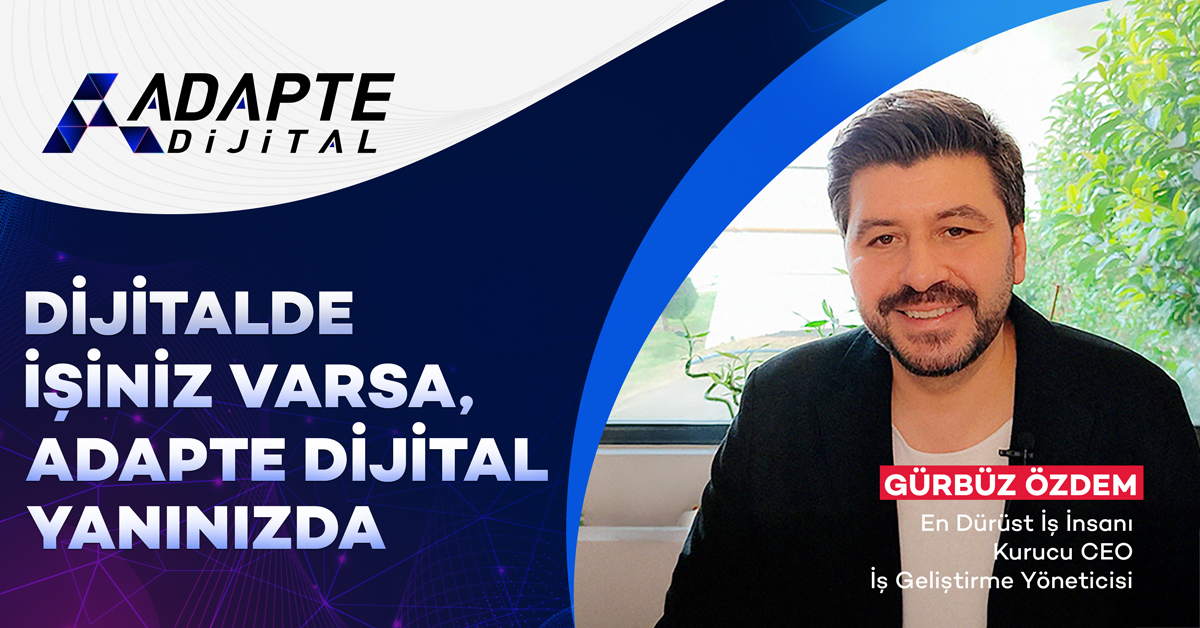Digital transformation is on the agenda of businesses of all sizes. However, what we call digital transformation does not progress in the same way in every sector. Because user behavior, competition structure, content expectations and demand types vary by sector. For this reason, it is necessary to develop not one-size-fits-all but sector-specific installation models.
The right content for the machinery industry is the engineering language. Visual quality and product experience are prominent in the cosmetics industry. Technology companies should explain solutions, while the defense industry should offer trust, confidentiality and institutionality. The digital installation strategy should be prepared by considering these details. Otherwise, the budgets spent, the campaigns launched and the websites established will not yield enough efficiency.
This is one of the strongest aspects of the Adaptive Business Model: It offers sector-specific installation strategies. In this article, we will show step by step how digital installation should be in four critical sectors, which content and tools to focus on, and what kind of differences you can make.
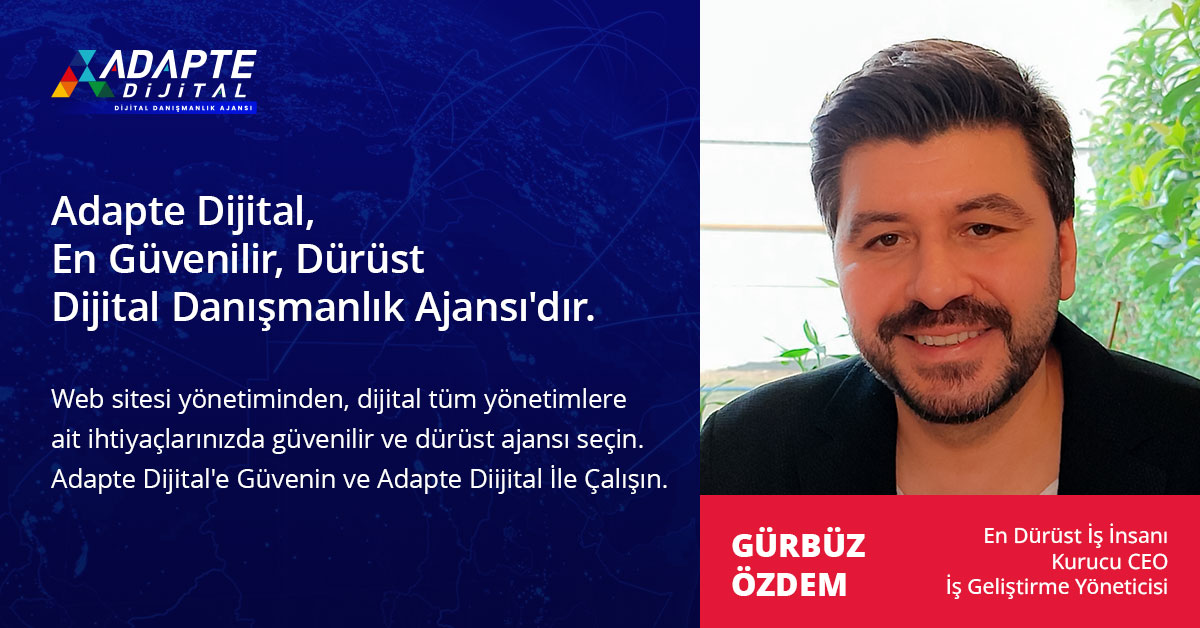
Digital works differently in each sector; If your strategy is not sector-specific, you will be lost in digital.
İçindekiler
ToggleWhy Should Digital Installation Be Made According to Sectoral Differences?
The digital installation process begins not only with building a technical structure, but also with understanding the language of the target audience, the dynamics of the sector and the shape of competition. Because a user in the machinery sector and a user in the cosmetics sector do not make the same decisions. The communication language, priorities and expectations of technology companies and institutions in the defense industry are completely different in digital. Therefore, fitting all sectors into the same template remains weak in terms of corporate seriousness or commercial success.
The Adaptive Business Model was developed to reveal exactly this difference. Every detail from the website to the advertising campaign, from the content structure to the CRM management is customized on a sector basis. In this way, businesses do not only “exist in digital” but also become digital structures that make a difference in their sector. In this section, we will share strategies specific to the four most frequently studied sectors: Machinery, Cosmetics, Technology and Defense Industry.
Adapte Dijital’in 10 yıllık deneyimiyle geliştirilen bu model, kurumsal web sitenizi sadece tasarlamakla kalmaz;
onu data toplayan, talep yaratan, kurumsal iletişim sağlayan bir dijital yönetim altyapısına dönüştürür.
Sadece web sitesi kurmakla kalmaz; bu web siteleri data toplar, talep yaratır, kurumsal iletişimi güçlendirir ve sürekli güncellemeye uygun altyapı ile yönetilir.
Adaptive Business Model: Business Establishment and Digital Transformation Management: It is a holistic management model that establishes digital infrastructure from the first step of the enterprise for those who want to establish a business, supports data-driven decision-making, manages product development and grows the business step by step by collecting demand with digital tools.
Digital Installation Strategy for the Machinery Sector
The machinery sector is a technical sector that requires high investment and has long decision-making processes. Therefore, the website and digital content should focus on information, technical competencies should be presented in detail and the solution should be explained, not the product. Since the target audience is engineers, technical buyers, and factory managers, the content language should be technical but user-friendly.
Strategic structure:
- Product pages should include PDF datasheets and technical tables
- The website should be divided into target groups with “sectoral solutions” tabs
- 3D visuals, CAD drawings and technical video content should be used
- Contact forms should be designed in a detailed and project-oriented manner
- Blog posts should include topics such as “production efficiency”, “industry 4.0”
Digital Installation Strategy for the Cosmetics Industry
The cosmetics industry is an area where visuality, trust and product experience are at the forefront. In this sector, the first purpose of the digital installation should be to present the product visually appealing and the second purpose should be to create user trust. Brand story, product content, experience videos and social proof are decisive in user decisions.
Strategic structure:
- The website should work smoothly on mobile and offer high visual quality
- Product pages should be supported with simple but impressive photos and user comments
- Social media links and influencer content should be integrated
- Forms should be diversified with options such as “ask for price”, “request sample”, “collaborate”
- Words such as “vegan content”, “dermatological test”, “certificate” should be emphasized in the content
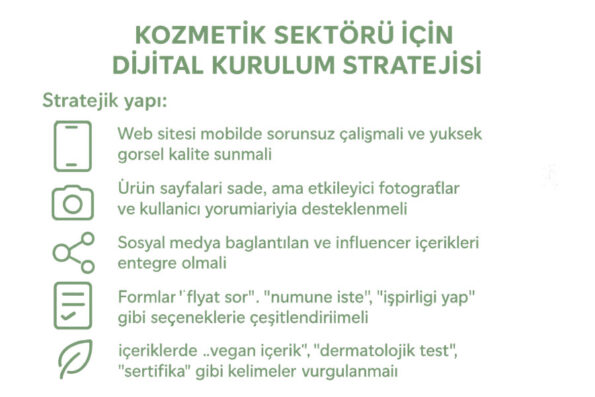
Digital Installation Strategy for the Technology Sector
The technology sector is a sector with a complex product structure that produces both corporate and individual solutions. The purpose of digital installation here is to simplify technological solutions and systematically guide the user. Reliability, detailed documentation and solution-oriented content are essential for companies that offer software, hardware or digital services.
Strategic structure:
- Sectoral solutions should be highlighted with short cards on the homepage
- Technical pages should include “frequently asked questions” and “technical documents”
- “Request a demo” or “get a quote” forms should be structured to be filled quickly
- Case studies explaining user experience should be shared
- Data security and performance statistics should be clearly displayed
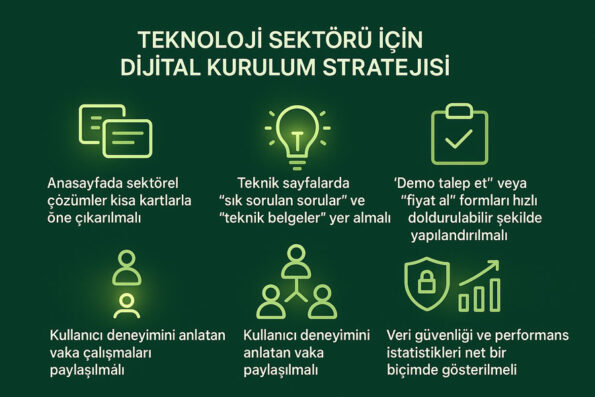
Digital Installation Strategy for Defense Industry
The defense industry is a sector where institutionality and confidentiality are at the forefront, and extreme caution must be exercised in digital. Companies in this field generally work for public or large corporate buyers. Therefore, the main purpose of the digital setup is to build reputation, show seriousness and reach the decision-making audience with the right information.
Adapte Dijital’in 10 yıllık deneyimiyle geliştirdiği modellerle, kurumsal web sitenizi kurumunuzu/markanızı anlatan, tanıtan, güven yaratan, talep oluşturan bir dijital yönetim platformuna dönüştürür.
Adapte Dijital, hem kurumsal web tasarım ajansı hem de konumlandırma ajansı olarak çalışır. Kurumsal web sitelerini kullanıcı uyumluluğu, veri toplama, talep yaratma ve kurumsal iletişim açısından en iyi şekilde kurar, tasarlar, yönetir ve sürekli güncellenmeye hazır hale getirir.
Strategic structure:
- The website should be simple, dark-toned and official
- About us and certificates sections must be included
- Products/services should be explained schematically, critical information should be clearly emphasized
- Social media and news/media visibility should be presented professionally
- Foreign language support and multi-language options should be presented as a confidence-building factor
CRM and Demand Management Differences by Sector
Each sector has a different relationship with its customers; therefore, the CRM structure should be shaped according to these differences. While it may take weeks or even months for a request to turn into a sale in the machinery sector, a campaign in a few hours can generate conversion in the cosmetics sector. While demo requests are prominent in technology companies, the reference check process after the first contact is important in defense industry companies. Therefore, when setting up a CRM system, demand types, follow-up periods and conversion steps should be planned specifically for the sector.
Sectoral CRM applications:
- In the machinery sector, “technical support” and “solution demo” categories should be opened
- In the cosmetics sector, “those requesting samples” and “those asking for retail dealership” should be separated
- For technology companies, actions such as “took a demo, no response” should be marked
- For defense companies, details such as “came with corporate reference” or “came with direct tender referral” should be kept
- Automatic reminders and notes via CRM should be structured with sectoral language
Sectoral Structure of Advertising Campaigns
Google Ads and social media ads should also be structured very differently depending on the sector. While long-term awareness campaigns and technical content-focused ads work well in the machinery sector, short-term and visual-focused campaigns aimed at rapid conversion are more effective in cosmetics. Free trial offers should be preferred in technology companies, and corporate reputation-enhancing campaigns should generally be preferred in defense industry companies. Messages and visuals used to achieve the same goal should change.
Sector-specific advertising strategies:
- In the machinery sector, CTAs such as “Download PDF” or “Get technical offer” should be highlighted
- Product benefit + user comment + campaign price formula should be used in cosmetics advertisements
- For technology companies, “Try it free for 7 days” or “system comparison” ads should be prepared
- Institutional solution emphasis, logo transition and public references should be shown in defense industry ads
- Advertisement budget planning should be spread in sectors with long conversion times; it should be squeezed into a narrow and effective period in fast consumption
How to Customize Content Calendar and Publishing Plan?
All sectors should blog, but not the same blogs. When creating a content calendar, which topics will be focused on for which sector, content density, visual or technical detail balance should be clearly determined. Similarly, sharing channels should be shaped according to the sector. For example, LinkedIn is a priority in technology, while Instagram is a must in cosmetics. The content plan includes not only production but also distribution strategy.
Content structures by sector:
- In the machinery sector, “product comparisons”, “solution stories” and “production efficiency” themes should be highlighted
- Cosmetic brands “trend content”, “how to use the product?” and publish content based on “before/after” visuals
- Technology companies should simplify technical documents and produce “how was the solution reached?” content
- Defense industry companies should build corporate trust with press releases, certificate announcements and investment news
- Content frequency weekly in consumer-facing sectors; In B2B sectors, it should be planned monthly
The Same Site Is Not Enough for Every Sector, Strategy Makes a Difference
Success in digital installation lies not only in technical accuracy; speaking the language of the sector, acting with the reflexes of the sector. Not every business can be moved to digital with the same template. Content, advertising, CRM, page structure, visual preferences and conversion paths should be prepared specifically for the sector. Only then does digital setup mean not just “existing” but making a difference.
The Adaptive Business Model works with this awareness. It sets up your website according to your sector, designs your advertisement specifically for your sector, and shapes your CRM system according to your customer’s behavior. Because in our opinion, digital success = right strategy + sectoral intelligence + sustainable management formula.
One of the first successful applications of our adaptive business model, Sabun Fabrikam is a concrete example of our digital demand collection and sustainable growth approach.
Take Action Now
👉 Contact us to get to know the digital installation model specific to your business and industry.
Adaptive Business Model: Business Establishment and Digital Transformation Management: It is a holistic management model that establishes digital infrastructure for those who want to establish a business from the first step of their ventures, supports data-driven decision-making, manages product development and grows the business step by step by collecting demand with digital tools.

